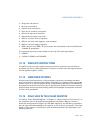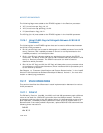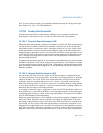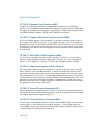
Vol. 3 19-9
ARCHITECTURE COMPATIBILITY
XCHG BP, [BP]
This code functions as the 8086 processor PUSH SP instruction on the P6 family,
Pentium, Intel486, Intel386, and Intel 286 processors.
19.17.2 EFLAGS Pushed on the Stack
The setting of the stored values of bits 12 through 15 (which includes the IOPL field
and the NT flag) in the EFLAGS register by the PUSHF instruction, by interrupts, and
by exceptions is different with the 32-bit IA-32 processors than with the 8086 and
Intel 286 processors. The differences are as follows:
• 8086 processor—bits 12 through 15 are always set.
• Intel 286 processor—bits 12 through 15 are always cleared in real-address mode.
• 32-bit processors in real-address mode—bit 15 (reserved) is always cleared, and
bits 12 through 14 have the last value loaded into them.
19.18 X87 FPU
This section addresses the issues that must be faced when porting floating-point
software designed to run on earlier IA-32 processors and math coprocessors to a
Pentium 4, Intel Xeon, P6 family, or Pentium processor with integrated x87 FPU. To
software, a Pentium 4, Intel Xeon, or P6 family processor looks very much like a
Pentium processor. Floating-point software which runs on a Pentium or Intel486 DX
processor, or on an Intel486 SX processor/Intel
487 SX math coprocessor system or
an Intel386 processor/Intel 387 math coprocessor system, will run with at most
minor modifications on a Pentium 4, Intel Xeon, or P6 family processor. To port code
directly from an Intel
286 processor/Intel 287 math coprocessor system or an
Intel 8086 processor/8087 math coprocessor system to a Pentium 4, Intel Xeon, P6
family, or Pentium processor, certain additional issues must be addressed.
In the following sections, the term “32-bit x87 FPUs” refers to the P6 family, Pentium,
and Intel486 DX processors, and to the Intel
487 SX and Intel 387 math coproces-
sors; the term “16-bit IA-32 math coprocessors” refers to the Intel 287 and 8087
math coprocessors.
19.18.1 Control Register CR0 Flags
The ET, NE, and MP flags in control register CR0 control the interface between the
integer unit of an IA-32 processor and either its internal x87 FPU or an external math
coprocessor. The effect of these flags in the various IA-32 processors are described in
the following paragraphs.
The ET (extension type) flag (bit 4 of the CR0 register) is used in the Intel386
processor to indicate whether the math coprocessor in the system is an Intel
287


















